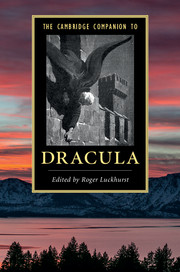Book contents
- The Cambridge Companion to Dracula
- Series page
- The Cambridge Companion to Dracula
- Copyright page
- Dedication
- Contents
- Notes on Contributors
- Note on the Text
- Chronology
- Introduction
- Part I Dracula in the Gothic Tradition
- Part II Contexts
- Part III New Directions
- Part IV Adaptations
- Guide to Further Reading
- Index
- Cambridge Companions to …
- References
Guide to Further Reading
Published online by Cambridge University Press: 15 November 2017
- The Cambridge Companion to Dracula
- Series page
- The Cambridge Companion to Dracula
- Copyright page
- Dedication
- Contents
- Notes on Contributors
- Note on the Text
- Chronology
- Introduction
- Part I Dracula in the Gothic Tradition
- Part II Contexts
- Part III New Directions
- Part IV Adaptations
- Guide to Further Reading
- Index
- Cambridge Companions to …
- References
- Type
- Chapter
- Information
- The Cambridge Companion to Dracula , pp. 207 - 211Publisher: Cambridge University PressPrint publication year: 2017



